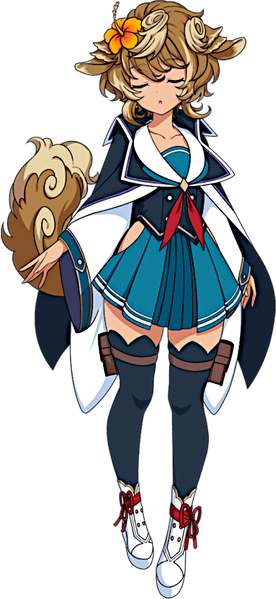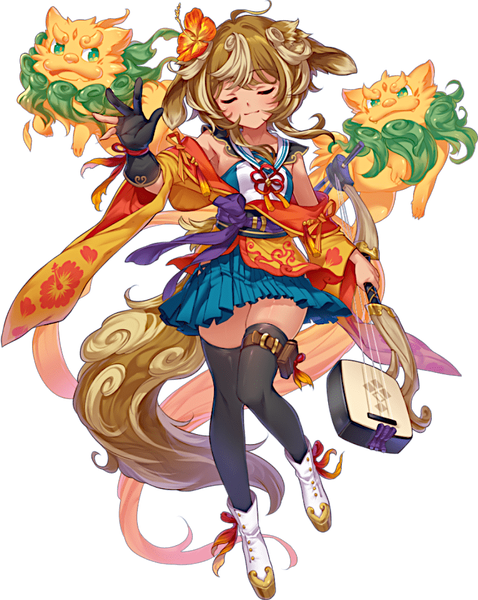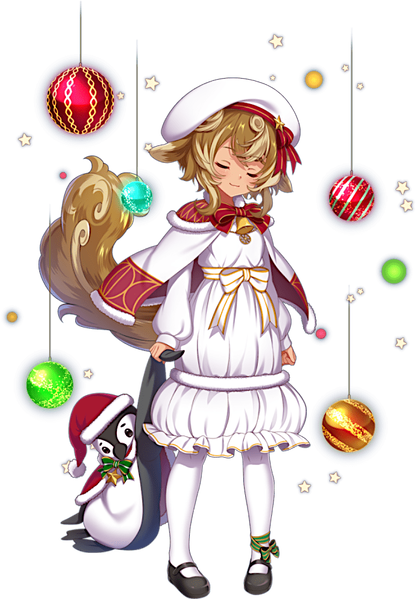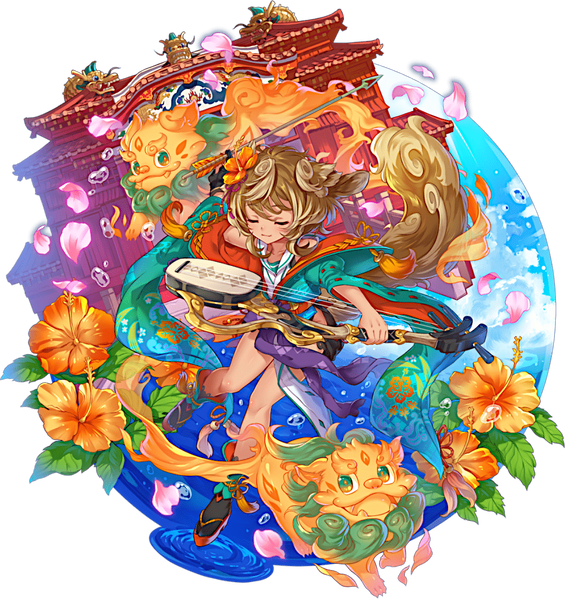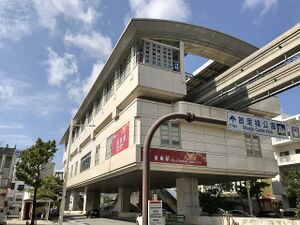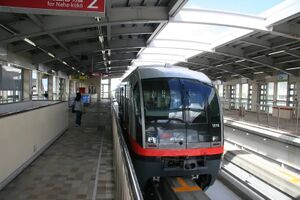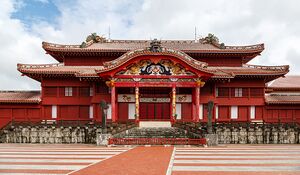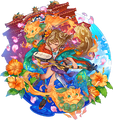Shuri
| Shuri | |||||
|---|---|---|---|---|---|
| Japanese Name | シュリ | ||||
| Weapon | |||||
| Race | Beast | ||||
| Nationality | |||||
| Birthday | August 10 | ||||
| Constellation | Leo | ||||
| Talents | Able to use a variety of different abilities | ||||
| Likes | Family, Nirai Kanai, Shamisen, Food of Uchina Kingdom | ||||
| Dislikes | Noise, Cold, Machinery (especially weaponry), Invaders, Filth | ||||
| Strengths | Does not judge things by their outward appearance alone | ||||
| Weaknesses | Cannot judge things by their outward appearance alone | ||||
| Hobbies | Playing in the sea, Partying while drinking Awamori, Being pampered by family | ||||
Ojii, Ojii, cuddle me~♪ Spoil me~♪ Eh? Self introduction? I'm a noro from Uchina Kingdom sa~♪ I was trapped inside Mannenyuki for eons, but Oka freed me so I can help work in Doubutsuen sa~♪
Layers
| Icon | Title | Release Date | Where to Obtain |
|---|---|---|---|
| [Awakened Noro] Shuri | 2023 May 8 | [Training Camp - Shuri] Event Reward | |
| [Visitor From the Ancient Times] Shuri | 2023 May 15 | [Love Me More Papa Perfume] Event Reward | |
| [Festive Song] Shuri | 2023 December 21 | [Christmas With the Reindeer] Limited Gacha | |
| [Scenery Seen Deep in the Eyes] Shuri | 2023 May 15 | [Love Me More Papa Perfume] Pick Up Gacha, Premium Gacha |
Obtained Skills
Trivia
- Shuri's birthday is the opening date of Shuri Station in 2003.
- Shuri's beast motif is a shisa. Shisa (シーサー, Shīsā, Okinawan: shiisaa) is a traditional Ryukyuan cultural artifact and decoration derived from Chinese guardian lions, often seen in similar pairs, resembling a cross between a lion and a dog, from Okinawan mythology. Shisa are wards, believed to protect from some evils.
- Shuri speaks in both Okinawan and Japanese languages, with greetings like Mensooree (めんそーれー, Welcome), Haitai (はいたい Hello (female only)), and frequently ending her lines in "sa". Okinawan language in real life is currently classified as an endangered language by UNESCO, and for political reasons is treated as a dialect by the Japanese government.
- Shuri is blind, the first and currently only character with full disability (Zouérat is partially blind, but can still see normally with her one working eye). Her dislike of noise is due to loud noises disrupting her "sight" with her reliance on hearing and vibrations in the air to sense her way.
- Nirai Kanai is the land of the gods, somewhat analogous to Heaven, and the place from which all life originates. It is worshipped facing eastward, as it is fabled to be somewhere in the Pacific Ocean. Gods from Nirai Kanai are said to have brought different crops and tools to the Ryukyuan people at different times. The Chinese characters "儀来河内" were historically used for their phonetics, but nowadays the name is rendered in katakana.
- The red castle in the backgound of [Scenery Seen Deep in the Eyes] is the Shuri Castle in Okinawa.
Counterpart
Shuri Station (首里駅, Shuri-eki) is a railway station on the Okinawa Urban Monorail (Yui Rail) located in Naha, Okinawa Prefecture, Japan. The station was originally planned to be named Tera Station (汀良駅, Tera-eki) after the neighborhood within Shuri, but opened as Shuri Station on August 10, 2003. It serves the center of downtown Shuri, Shuri Castle, and its environs. Shuri Station was originally the eastern terminus of the line. On October 1, 2019, a new eastward extension to Tedako-Uranishi was opened. The chime played to announce trains' arrival and departure is the traditional Okinawan nursery rhyme Akata Sunduchi.
Until the October 16, 2004 timetable revision, the Shonan Shinjuku Line (which operates from this station to Shinjuku) used to use the 215 Series trains that depart from this station (turnaround). The trains used were Series 215 trains. Since March 15, 2014, some Narita Express trains (Series E259 trains) departing from and arriving at Yokohama and Ofuna Stations have extended their service to Shuri Station as extra trains only on weekends and holidays during peak season, but the service was suspended in January 2017. Shuri Station is an elevated station with two relative platforms and two lines. From the time of opening until August 2019, track 1 was not used and only track 2 was used to turn back towards Naha Airport Station In September 2019, track 1 began operating as a drop-off only. After the Tedako-Urasai Station extension opened on 1 October 2019, trains are set to turn back at this station during weekday morning rush hours and directly enter and turn back to track 2.
In January 2005 (Heisei 17), a demonstration experiment was conducted to discount the fare to 50 yen when transferring from this station to the community bus (Ishimine-Shurijo Migui Line). This discount was changed to a 20 yen discount for adults and 10 yen discount for children at Nos. 7 and 8, where the community buses were converted into bus routes, when a valid one- or two-day Yui Rail ticket is presented. (The operation of Nos. 7 and 8 itself was transferred to Naha Bus and continued).
The Okinawa Urban Monorail (沖縄都市モノレール, Okinawa Toshi Monorēru), also known as Yui Rail (ゆいレール, Yui Rēru), is a monorail line serving the cities of Naha and Urasoe, Okinawa, Japan. Operated by Okinawa Urban Monorail, Inc. (沖縄都市モノレール株式会社, Okinawa Toshi Monorēru Kabushiki-gaisha), it opened on 10 August 2003, and is the only public rail system in Okinawa Prefecture. Yui Rail is the first rail line on Okinawa since World War II. As Okinawa is the island of Japan lying farthest to the south and west that has an active rail line, Akamine Station and Naha Airport Station, the southernmost and westernmost rail stations in Japan respectively, lie on this line. It uses the OKICA as its contactless smart card, and integrates with Suica and other major Japanese IC cards (such as ICOCA or SUGOCA) from 10 March 2020. Wikipedia
Shuri Castle (首里城, Shuri-jō, Okinawan: Sui Ugusuku) was a Ryukyuan gusuku castle in Shuri, Okinawa Prefecture, Japan. Between 1429 and 1879, it was the palace of the Ryukyu Kingdom, before becoming largely neglected. In 1945, during the Battle of Okinawa, it was almost completely destroyed. After the war, the castle was re-purposed as a university campus. Beginning in 1992, the central citadel and walls were largely reconstructed on the original site based on historical records, photographs, and memory. In 2000, Shuri Castle was designated as a World Heritage Site, as a part of the Gusuku Sites and Related Properties of the Kingdom of Ryukyu. On the morning of 31 October 2019, the main courtyard structures of the castle were again destroyed in a fire.
Unlike Japanese castles, Shuri Castle was greatly influenced by Chinese architecture, with functional and decorative elements similar to that seen primarily in the Forbidden City. The gates and various buildings were painted in red with lacquer, walls and eaves colorfully decorated, and roof tiles made of Goryeo and later red Ryukyuan tiles, and the decoration of each part heavily using the king's dragon. Given that the Nanden and Bandokoro were both used for reception and entertainment of the Satsuma clan, a Japanese style design was used here only. Ryukyuan elements also dominate. Like other gusuku, the castle was built using Ryukyuan limestone, being surrounded by an outer shell which was built during the Second Shō dynasty from the second half of the 15th century to the first half of the 16th century. Similarly, Okushoin-en is the only surviving garden in a gusuku in the Ryukyu Islands, which made use of the limestone bedrock and arranged using local cycads.
In the morning of 31 October 2019, a large fire broke out and burned down the Seiden, the main hall, and also the Hokuden and Nanden, adjacent buildings to the north and south. A security alarm went off around 2:30 a.m., and a call to emergency services was placed around 10 minutes later. The Seiden, Hokuden, Nanden and Bandokoro were completely destroyed. According to domestic news sources, "Six castle buildings occupying some 4,200 square metres (45,000 sq ft) in total were gutted." The fire was put out around 1:30 p.m. As of 10 February 2020, rebuilding efforts to restore the destroyed sections of Shuri Castle were underway. In May 2021, a scale replica of the castle measuring one twenty fifth of the size of the actual structure was recreated at the Tobu World Square theme park in Kinugawa Onsen. Wikipedia
Map
Gallery
- Pages using Tabber parser tag
- Pages using DynamicPageList3 parser tag
- Weapon Bow
- Beast
- Nishiki
- Leo
- Element Pierce
- Element Wind
- Element Light
- Metro Train Knights
- Japan

